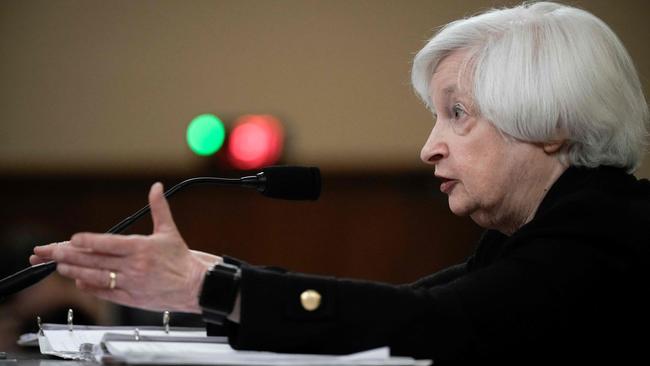There is a risk that the outcome of these two “tugs of war” may cause interest rates to stay high for longer, with obvious consequences to growth and general longer economic wellbeing.
In the US prior to the bank collapse, there was an increasing view of the Federal Reserve that the best strategy was to embrace the traditional American way of handling a crisis — attack the problem hard and accept the short-term pain for the long-term good.
And so markets were anticipating that the Federal Reserve would lift rates sharply, drive American economic activity lower – which will reduce price and wage rises forcing inflation down – and so allow lower rates and a resumption of growth to come much faster.
Post the bank collapse, that strategy becomes much more risky because it could blow apart large segments of the US banking and business community that have been damaged by the bank collapse and its repercussions.

US Treasury Secretary Janet Yellen has rejected pressure to “rescue” the SVB and instead is trying to insulate regional banks from any deposit runs by allowing them to park their bonds with the central bank at face value.
This therefore delays the crystallisation of the market losses in those bond portfolios – a major reason for the Silicon Valley Bank collapse.
But that action won’t help the turmoil in the tech sector and the general economy as a result of a shortage of funds, which is spilling over into the ability of private equity to continue helping the companies they have supported.
This underlying turmoil could be turned into a nasty crisis if the Federal Reserve returned to its previous plan of much higher interest rates and a sharp shock.
Here in Australia, the possibility of a sharp shock in US interest rate rises was a scary thought because the Reserve Bank of Australia would then be put under pressure to follow – because if it didn’t, the Australian dollar would be trashed.
Australia has a different version of the same US problem. With his traditional central bank hat on, Reserve Bank governor Philip Lowe theoretically would have loved to adopt the previous Federal Reserve plan and lift interest rates sharply to kill off inflation, and then enable a return to more normal rates over a short period.

But because of the bank mortgage lending spree of two years ago, a sharp rise in interest rates would devastate the Australian economy, particularly the banking and housing sector. Already throughout the business community people are slowing down their payment of debts and in the general population the number of people who are employed but who can’t make ends meet is rising rapidly. A sharp rise in interest rates would devastate the nation.
Of course, the great advantage of a sharp blow to the economy is that the medicine, while severe, enables the resumption of growth much faster.
Now both the US and Australia face the possibility of a continuation of high rates (but not sharply higher) for a much longer period than either country would like.
That means lower growth and less prosperity. The markets have a whiff of this possibility and so we see shares fall in value, and yet bond yields also fall as people rush for security and also recognise that the risk of much higher rates has been greatly reduced.
For Australia that presents several risks that will require great skills in management.
First, our defence commitments are set to explode and we need to find a way to fund these commitments in a low-growth environment in both Australia and the US. This is not an inviting prospect because the current government does not have an appetite for substantial expenditure reduction.
Second, if the lower-level growth happens to spill over into lower commodity prices it would double the impact. Given the growing global electrification, that may not happen but it is a risk.
And finally our biggest source of our capital – superannuation – has been turned into a palace of fear because we have a government that didn’t take time to step back and plan what it was going to do after understanding all the implications.
And so we have a franking credits mess and a superannuation investment cap that introduces draconian taxes to enforce it. That’s a perfect recipe to scare people, not just those with $3m-plus portfolios.
We will see a rise in more conservative investment portfolios that carry lower risk. That means that the innovative companies which abound in Australia will find it harder and harder to gain capital backing, and in turn that lowers our productivity.
Australia has an underlying shortage of highly skilled people in the technology arena. The extensive problems that the American tech sector now faces means that, as never before, there will be top people available in the US. It’s an opportunity that will not last for an extended period.
But the number of Australian enterprises able to tap this sudden emergence of high-technology people is set to be limited, although those which have hired extensively in the past year or so will be reviewing past hirings with an eye to replacing non-performers with the top US people who are now available.
That possibility is sending a shiver through technology people employed not just in hi-tech companies but across the board.








The collapse of the Silicon Valley Bank and its dangerous implications for the US economy now brings America into line with Australia: the central banks in both countries are now engaged in a tense tug of war between the community damage from higher interest rates and the desire to reduce inflation quickly.